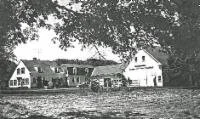Photo caption: The oldest part of 125 Cable Road may date to before 1700. The Jenness family continuously occupied the house until 1908.
By Marie Fort Withrow
Francis Jenness was likely a young man in his early 30’s when he sailed from Rye, Sussex, England for New England. Though his arrival date is debated, it is generally accepted as 1665 when he took up residence at the Great Island, later to become New Castle. This is where on October 2, 1666 he took the Freeman’s Oath of Fidelity.
The next year Francis received a grant from the selectmen of Portsmouth for one acre of land on Great Neck. It was stipulated that he build a house on the property within one year. Despite the fact that he had not fulfilled this requirement, the town gave him “absolute conveyance” of the lot, for which he paid 20 shillings. For several years Francis worked here as a mariner and fisherman until his marriage on February 15, 1669/70 to Hannah Swaine, daughter of William Swaine and Prudence Marston of Hampton, where they made their first home.
In 1675 Francis built the house wherein he and Hannah would live for most of their lives and raise seven children. The land, laid out by the town of Hampton, extended along the seacoast from Lock’s Neck heading south more than half a mile. He also erected a sawmill, grist mill, and a bakery where he made bread and sea biscuits which he sold along the seacoast from Saco to Boston. With his property so close to the water Francis was able to use small boats, likely ketches, or pinnaces, to ship his wares. During this time he is also listed among the men who served in the military campaign during the Native American uprising.
There is great variation of the spelling of Jenness in deeds, histories, and town and vital records. Just some of the these include Jennings, Gennings, Genis, Jenis, Janis, and Jinnis. It was not until around 1730 that the spelling stabilized as Jenness.
In partnership with others, Francis established a successful sawmill on Cedar Swamp Run in 1695. (For the story of The Mills and Cedars of Rye, please visit https://www.ryenhhistoricalsociety.org/mills-cedars-of-rye .) His business ventures must have been very profitable as Francis continued to purchase property throughout the area. Hannah Jenness died in 1699 and a little more than a year later Francis married twice widowed Salome White of Portsmouth.
Like other early settlers Francis was involved in several boundary disputes. Apparently, he ruffled enough feathers that when he tried to protest during a meeting of the commoners in 1707, he was denied the right to speak. He is often listed as a dissenting vote in meeting notes. Some years after Francis died, his sons successfully gained back all the land that had been disputed.
By the time of his death at the age of 82, Francis Jenness had acquired enough land to leave significant acreage to his wife and his sons, and to also provide for his daughters. His youngest son, Richard, the most educated of his children, was one of the selectmen who began petitioning for separation from Newcastle in 1721. When this effort finally met with success in 1726, Richard was elected to represent the Parish of Rye, a position he held for almost 40 years. It is surmised that the name Rye was chosen to honor Francis Jenness as he was the only founder born in Rye, England. In 1730 Richard Jenness, with other families, petitioned successfully to annex their properties from Hampton. adding roughly eighteen hundred acres of good land to Rye.
Over the next 100 years the Jenness family continued to flourish and to contribute to the growth and stability of Rye. By the late 1800’s there were over 25 separate Jenness families living in south Rye west of Jenness Beach. Many of the heads of these families were farmers and some lived on land originally purchased by Francis Jenness.



